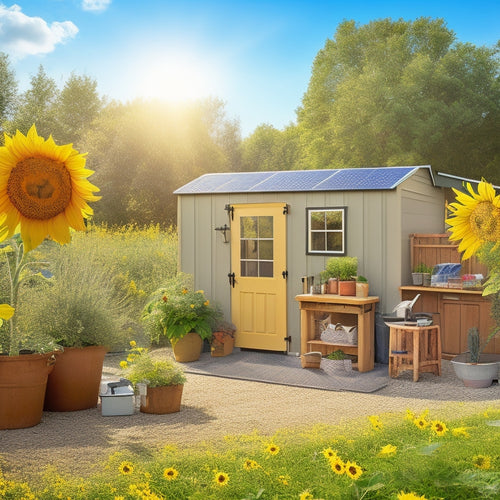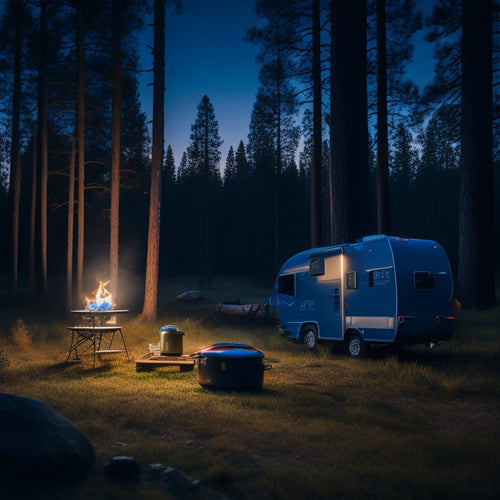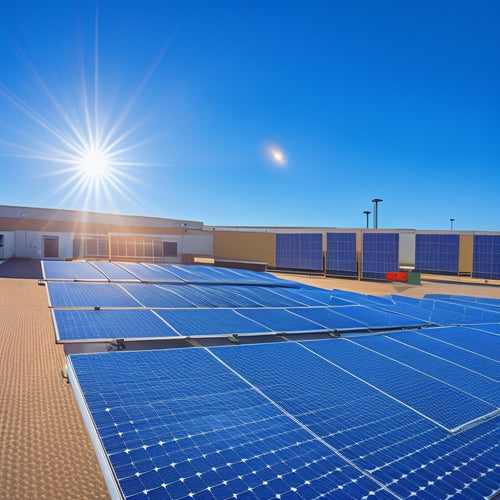
Top DIY Home Energy Independence Kits
Share
You're taking control of your energy costs and carbon footprint by opting for DIY home energy independence kits, which allow you to utilize renewable energy sources and reduce your reliance on the grid. Top DIY solar panel kits include solar panels, mounting hardware, and inverters, while portable power stations like Jackery Explorer 500 and Goal Zero Yeti 400 provide backup energy storage. Wind turbines and hydro power can enhance your energy supply, and you'll want to evaluate essential solar accessories like battery storage systems and monitoring tools. By combining these components, you'll be well on your way to achieving energy independence, and investigating further will reveal the best solutions for your specific needs.
Key Takeaways
- Consider energy needs, roof size, and local building codes when selecting a DIY solar panel kit for home energy independence.
- Off-grid systems are ideal for rural areas, enhancing energy efficiency and reducing grid reliance with solar power.
- Combine solar kits with energy efficiency tips like sealing leaks and upgrading to LED bulbs for maximum energy savings.
- Portable power stations provide backup energy storage for solar setups, with key models including Jackery Explorer 500 and Goal Zero Yeti 400.
- Assess local renewable potential and select suitable system components, including wind turbines and hydro power, for a comprehensive DIY energy independence kit.
Top DIY Solar Panel Kits
With rising energy costs and growing concerns about climate change, utilizing solar power has become an attractive solution for homeowners. You can take advantage of this clean energy source by installing a DIY solar panel kit on your roof.
These kits typically include solar panels, mounting hardware, and an inverter to convert DC power to AC. When choosing a kit, consider your energy needs, roof size, and local building codes.
Proper design considers energy requirements and battery capacity for reliability, making off-grid systems an attractive option for rural areas. A well-designed solar panel installation can increase your energy efficiency and reduce your reliance on the grid.
To maximize your energy savings, combine your solar panel kit with energy efficiency tips like sealing air leaks, upgrading to LED bulbs, and optimizing your HVAC system.
Best Portable Power Stations
As you harness the power of solar energy, you may find yourself needing a reliable backup plan for when the sun doesn't shine. Portable power stations are an excellent solution, providing a convenient and efficient way to store and employ energy. When selecting a portable power station, consider the power station features that matter most to you.
| Model | Capacity (Wh) | Charging Capabilities |
|---|---|---|
| Jackery Explorer 500 | 518 | Solar, AC, Car, USB |
| Goal Zero Yeti 400 | 396 | Solar, AC, USB |
| Anker Powerhouse 200 | 576 | Solar, AC, USB, Car |
| EcoFlow River | 412 | Solar, AC, USB, Car |
Consider the capacity, weight, and charging capabilities when choosing the best portable power station for your needs.
Renewable Energy System Options
Your path to DIY home energy independence involves more than just utilizing solar power; it requires an all-encompassing renewable energy system that meets your specific needs.
You'll want to contemplate a combination of energy sources to guarantee a reliable supply. A wind turbine can be an effective addition, particularly in areas with consistent breezes. If you're near a stream or river, hydro power may also be a viable option.
Assess your location's renewable energy potential and select the most suitable system components. Additionally, it's essential to evaluate energy needs and reflect on factors like energy storage and maintenance costs to secure a sustainable system.
You'll need to evaluate your energy demands, available space, and local regulations to determine the ideal system configuration. By doing so, you'll be able to create a customized renewable energy system that provides the independence you're seeking.
Affordable Off Grid Solutions
Living off the grid doesn't have to break the bank. You can utilize renewable energy sources without incurring huge upfront costs.
Wind energy, for instance, is a cost-effective option, especially in areas with consistent winds. A small wind turbine can generate enough power to charge your batteries or power small appliances.
With the advancement of high-efficiency solar charging solutions, it's now possible to maximize energy harvest and reduce energy losses.
Hydro power is another affordable option, particularly if you have a stream or river nearby. Micro-hydroelectric systems can be installed at a fraction of the cost of traditional hydroelectric systems.
Essential Solar Accessories Needed
Its solar panel array is only as good as the accessories that support it. You need essential solar accessories to guarantee your DIY home energy independence kit runs efficiently.
A solar battery storage system is a must-have to store excess energy generated during the day for use at night or during power outages. Energy efficiency upgrades, such as LED lighting and power strips with built-in timers, help reduce energy consumption.
Additionally, consider a monitoring system to track your energy production and consumption in real-time. This will help you identify areas for improvement and optimize your energy usage.
With these essential accessories, you'll be able to maximize your energy independence and reduce your reliance on the grid.
Frequently Asked Questions
Can I Install a DIY Energy Kit on a Rented Property?
You'll need to review your rental agreement for any restrictions on modifications before installing a DIY energy kit on a rented property, ensuring you're aware of tenant rights and potential limitations imposed by your landlord.
Are Energy Independence Kits Suitable for Small Apartments?
As you gaze out your apartment window, envision a self-sustaining haven. You wonder if energy independence kits can thrive in compact spaces like yours. The answer lies in compact solutions that overcome apartment limitations, ensuring a harmonious blend of sustainability and urban living.
Do Energy Kits Work During Power Outages and Blackouts?
When the grid fails, you'll rely on power storage systems in your kit to provide backup energy; meanwhile, emergency lighting solutions, like LED bulbs or battery-powered lanterns, will keep your home illuminated during prolonged power outages and blackouts.
Can I Expand My Energy Kit as My Needs Increase?
As you steer through the world of renewable energy, you're wise to wonder: can you scale up your system as needs grow? Fortunately, yes, you can expand your energy kit by adding more energy storage and leveraging system scalability to meet increasing demands.
Are DIY Energy Kits Compatible With Existing Electrical Systems?
When you're considering DIY energy kits, you'll want to verify they're compatible with your existing electrical system, addressing compatibility concerns and installation requirements to assure a seamless integration that meets your specific needs and local building codes.
Related Posts
-

Building an Emergency Backup Solar Power System in 5 Essential Steps
Building an emergency backup solar power system involves five key steps. First, assess your daily energy needs to ide...
-

Top Portable Refrigerators for Camping Adventures
When you're camping, having a reliable portable refrigerator can make all the difference for keeping your food fresh ...
-

Essential Solar Panel Mounts for Commercial Properties
When it comes to essential solar panel mounts for your commercial property, durability and wind resistance are key fa...


